Ontario PCs lead by 8: Debate does little as the desire for change drops
May 23, 2022
With less than two weeks to go before the Ontario election ends, we just completed a survey of 1,500 eligible voters conducted from May 18 to 21, 2022.
Here’s a quick summary of the results:
- PCs lead by 8 over the OLP (PC 36, OLP 28, NDP 24)
- The Leaders’ Debate lifts the image of all four leaders.
- Doug Ford wins the debate because he didn’t lose it.
- More now think the PCs will win the election.
- NDP and OLP continue to almost evenly split support among “change voters”
DETAILED RESULTS
PC LEAD HOLDS: PCs AHEAD BY 8 AS OLP AND NDP VOTE SHARE HOLD STEADY
If the election was held today, the PCs would win the popular vote easily over the Ontario Liberals. Overall, among all committed eligible voters in our survey, the PCs have 36% of the vote (up 1) with the Ontario Liberals at 28% (unchanged) and the Ontario NDP at 24% (unchanged). The Ontario Greens are at 5% (unchanged) while other parties get 8% of the vote (up 1).
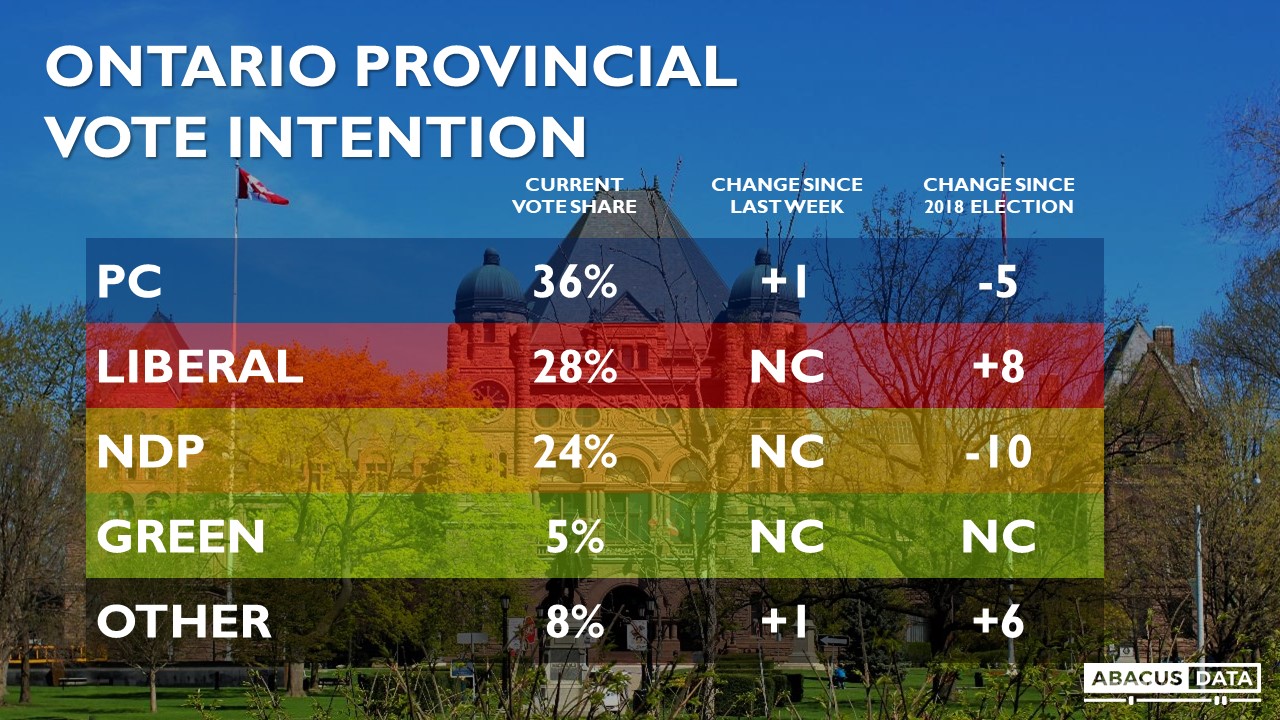
Regionally, we find the PCs ahead or statistically tied in all regions of the province. They lead by 3 over the OLP in Metro Toronto, lead by 4 in the rest of the GTHA, ahead by 19 in Eastern Ontario and ahead by 14 points in southwestern Ontario.
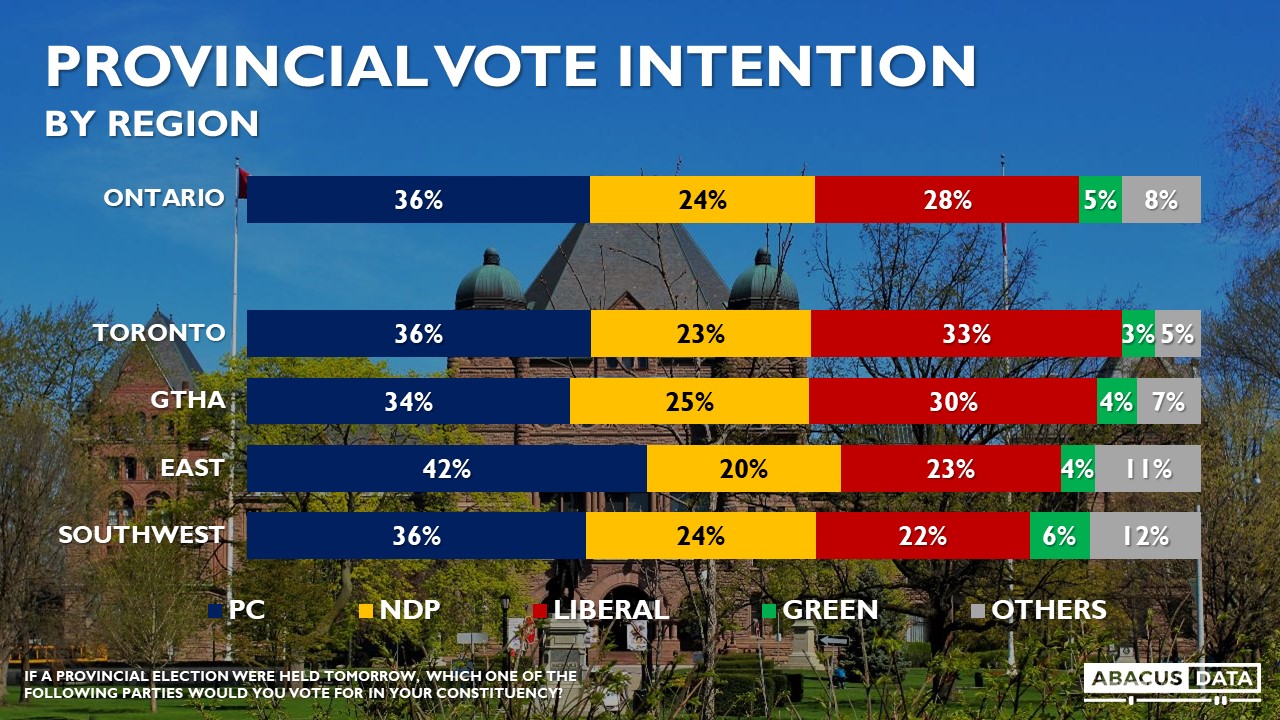
The PCs have a 22-point lead among those aged 60 and over, and a 12-point lead among those aged 45 to 59. The PCs and Liberals are tied among those aged 30 to 44 while the Liberals and NDP are tied among those aged 18 to 29. Only 1 in 5 younger voters say they will vote PC.

Among those most likely to vote, the gap between the PCs and Ontario Liberals grows to 12-points with the PCs at 39%, the Liberals at 27%, and the NDP at 22%. This is almost the exact same results as last week.

WHY HAS THERE BEEN LITTLE MOVEMENT IN THE CAMPAIGN SO FAR?
#1 – Attention to the campaign has increased, but not by much.
When asked how closely they are following the election campaign, 54% are following it very or somewhat closely (up by 5 points from last week) while 46% are following it only a little, not at all, or didn’t even know there was an election.

But the PCs are leading among those following the campaign very closely (44% to 28% for the OLP) and among those who say they are following it somewhat closely (38% to 27%).
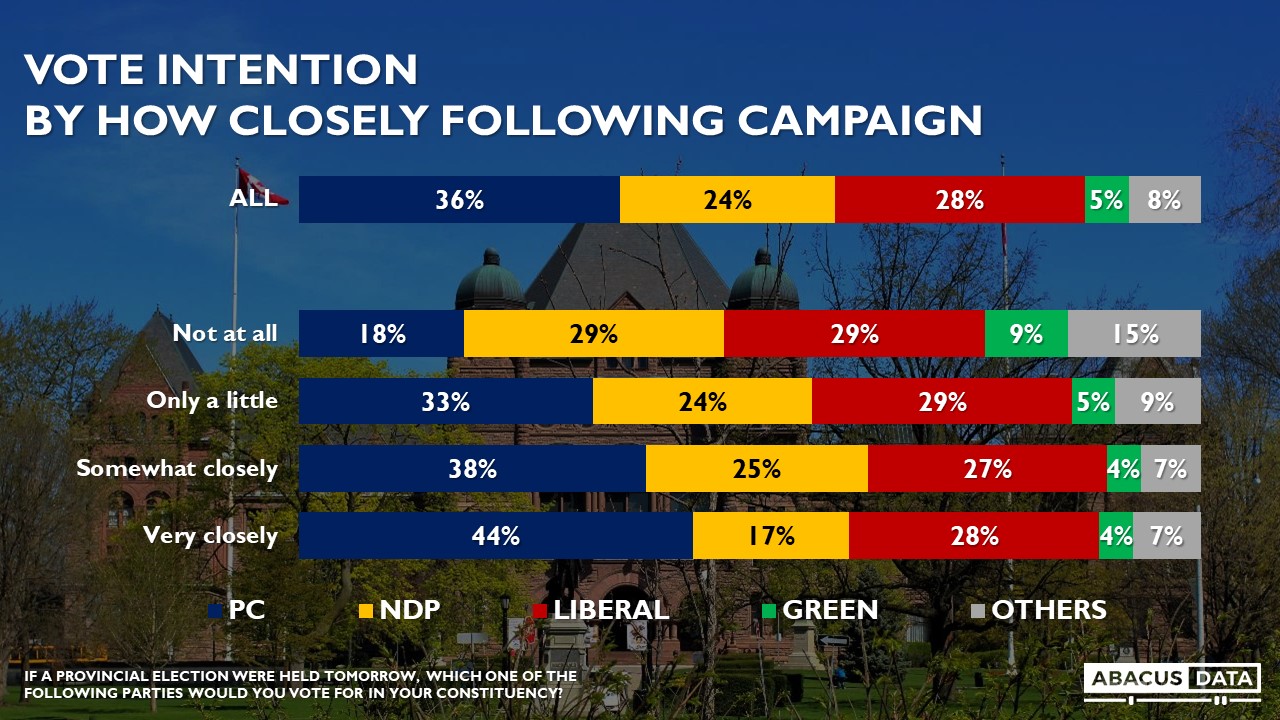
#2 – The desire for change is down by 4 points.
Over the past week, those definitely wanting to see a change in government have dropped by 4-points to 48% while those wanting to see the PCs definitely re-elected have increased by 2-points. Typically, we see the desire for change increase as a campaign goes on. This is unusual and unique to this campaign.

The desire for change in Ontario is far lower than the week before the 2018 provincial election and lower than in the final weekend of the 2021 federal election.
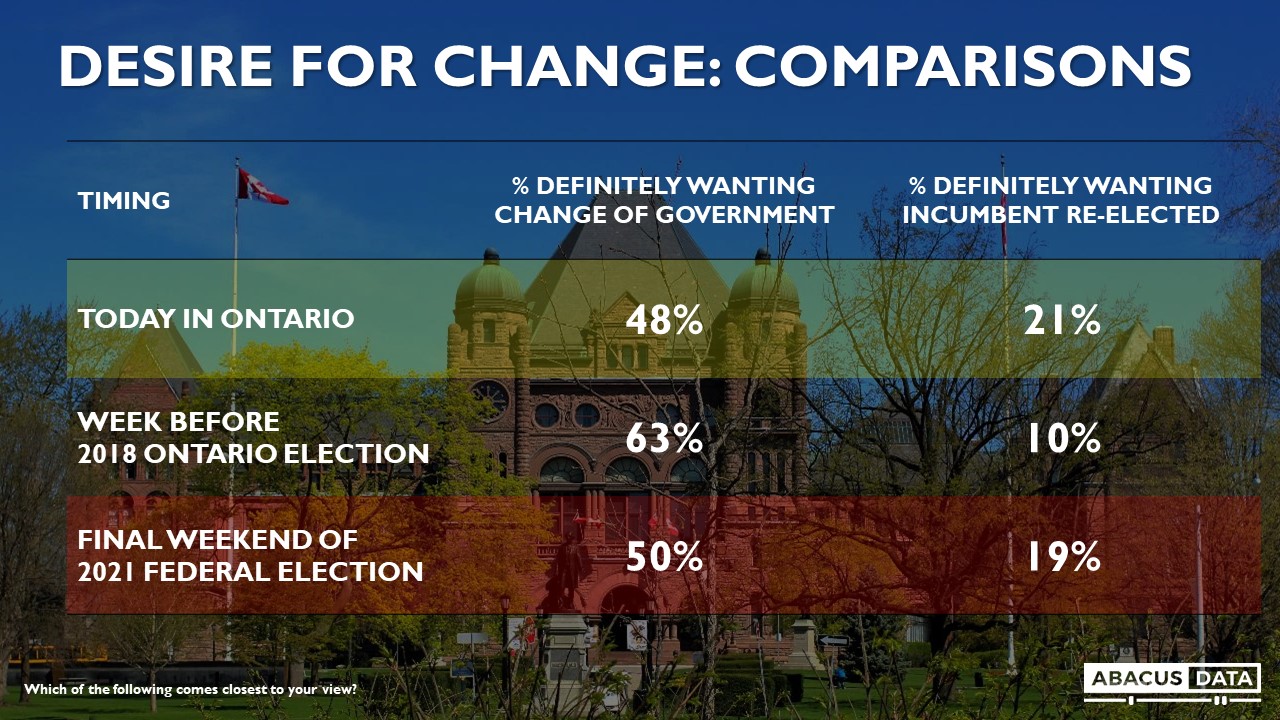
The NDP and OLP continue to split support among “change voters”. The Liberals have gained 3-points in the past week but the two parties get almost an equal share of this group which almost entirely explains why neither has made any gains in vote intention province-wide. Unless this changes in the final week and half of the campaign, the PCs should be very well positioned to win.
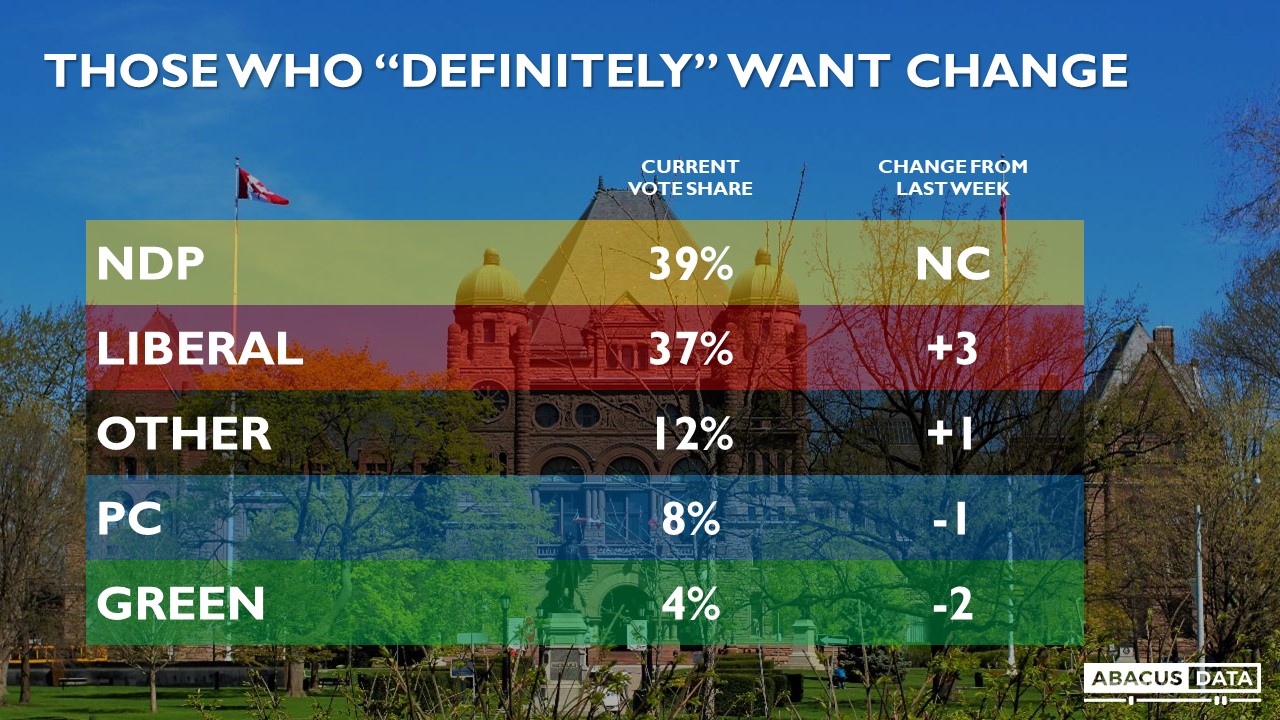
#3 – DEBATE REACTION: None of the leaders won or lost the debate, meaning Doug Ford won the debate.
In this survey, respondents were asked whether they watched or heard about the leaders’ debate held on Monday May 16 and what their reaction was among those who had watched or heard about it.
When asked which leader did the most to win their vote, 35% picked Doug Ford followed by Del Duca at 19%, Horwath at 20%, and Schreiner at 8%.
When asked which leader did the most to lose their vote, Doug Ford was most likely to be selected again with 32% followed by Horwath and Del Duca at 20% and Schreiner at 6%.

When asked whether their performance at the leaders’ debate left them with a positive or negative impression, all four leaders were net positive meaning more said they had a favourable impression of them at the debate than a negative one.
Overall, Mike Schreiner had the highest net positive (+29), followed by Horwath (+26), Ford (+20), and Del Duca (+13). Based on these results, none of the leaders really lost the debate and everyone made at least a net favourable impression.
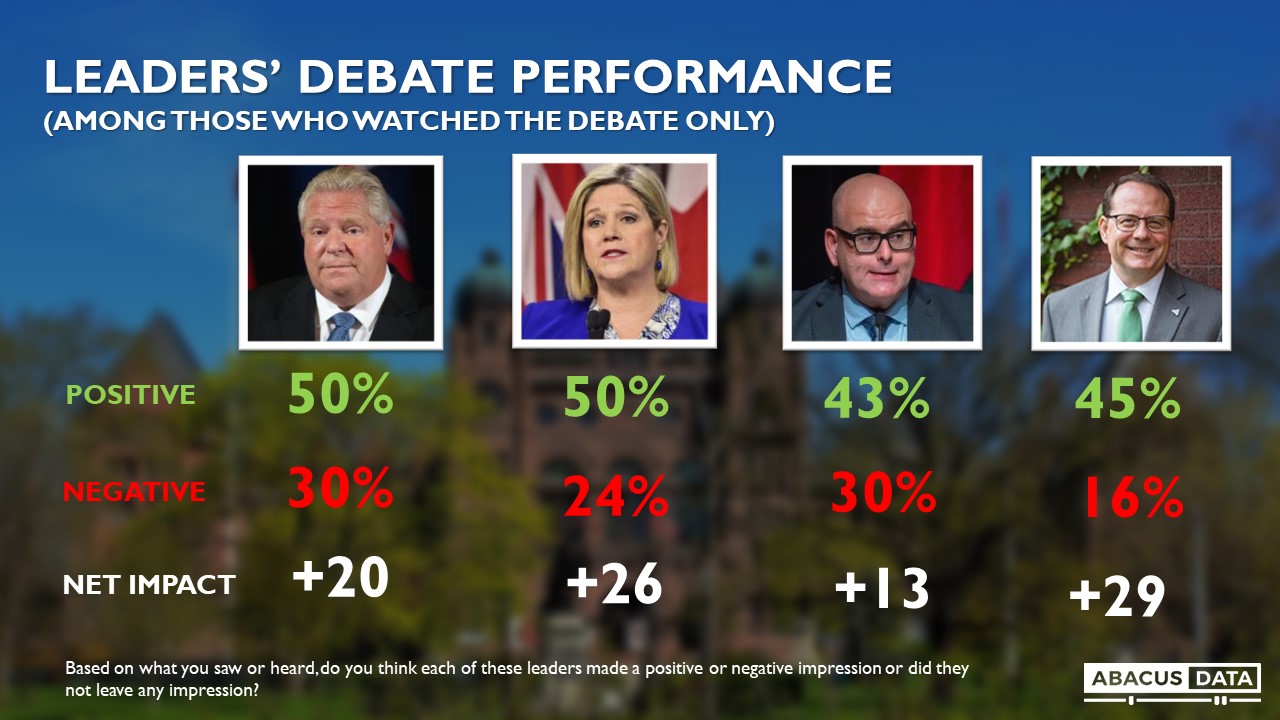
#4 – Doug Ford’s personal image has improved again, as have
Since last week, Doug Ford’s positives are up 6-points while his negatives are down 5. An equal proportion of eligible voters have a positive and negative impression of the PC Leader.
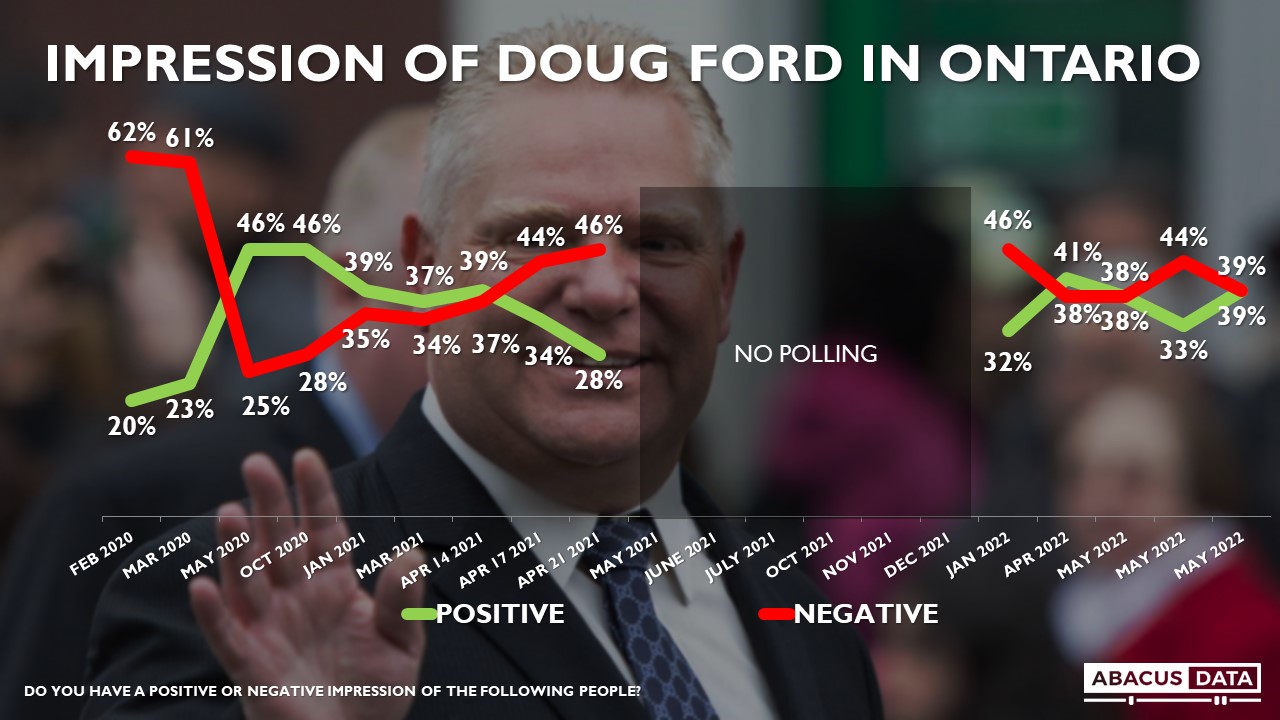
Ms. Horwath’s positives are up 4-points, Mr. Del Duca’s are up 5-points, while Mike Schreiner has seen a 7-point increase in those who have a positive view of him. Mr. Del Duca has the worst net impression with a score of -10. Mr. Schreiner is at -4 while Ms. Horwath and Mr. Ford are tied at 0.
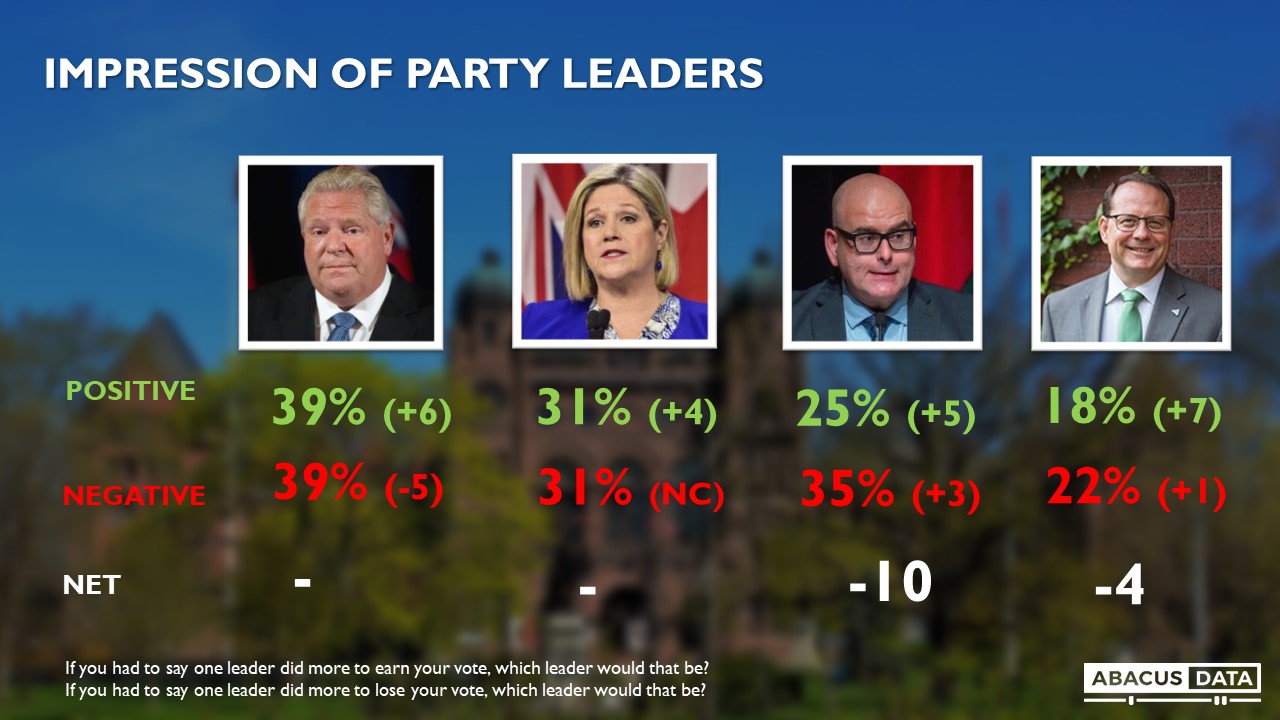
Since the start of the campaign, about equal numbers of people say their impression of Doug Ford has improved or worsened. Ms. Horwath has seen the most positive improvement (+8) followed by Mr. Schreiner (+7). While more people in total say their impressions of Mr. Del Duca have changed – not surprising because of how few people knew of him – about equal numbers say their impressions have improved or worsened. In other words, Mr. Del Duca’s performance on the campaign has earned him as many supporters as he has detractors.

Doug Ford remains well ahead on which leader would make the best premier. 35% pick Mr. Ford (up 1) followed by Ms. Horwath at 19% and Mr. Del Duca at 16%. 25% were unsure down 4 from last week.
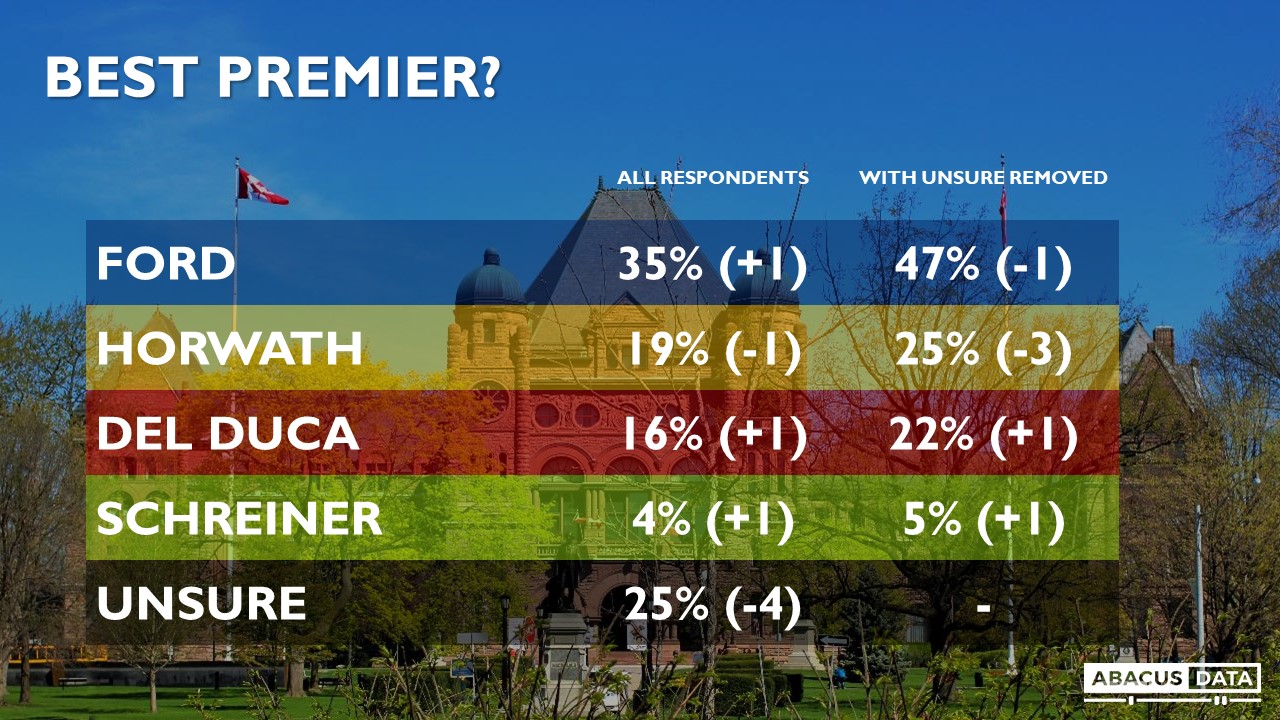
#5 – More now think the PCs will win the election with the NDP well back in third.
When asked which party they think will win the election, 45% think the PCs will win (up 3 from last week) while 22% think the Liberals will. Only 10% think the NDP will win.

#6 – The PCs continue to own and are competitive on the top issues of the campaign.
When asked what three issues are most likely to impact their vote, “reducing the cost of living” remains at the top of the list with 64% putting it in their top 3 (up 2). “Housing affordability and accessibility”, “improving the healthcare system”, “keeping taxes from going up”, and “growing the economy and creating good jobs” round out the top 5. The only noticeable change from last week is a 3-point increase in those saying “long-term care and seniors care” was a top issue from 19% to 22%. There has also been a 3-point increase in those selecting “responding to the COVID-19 pandemic).
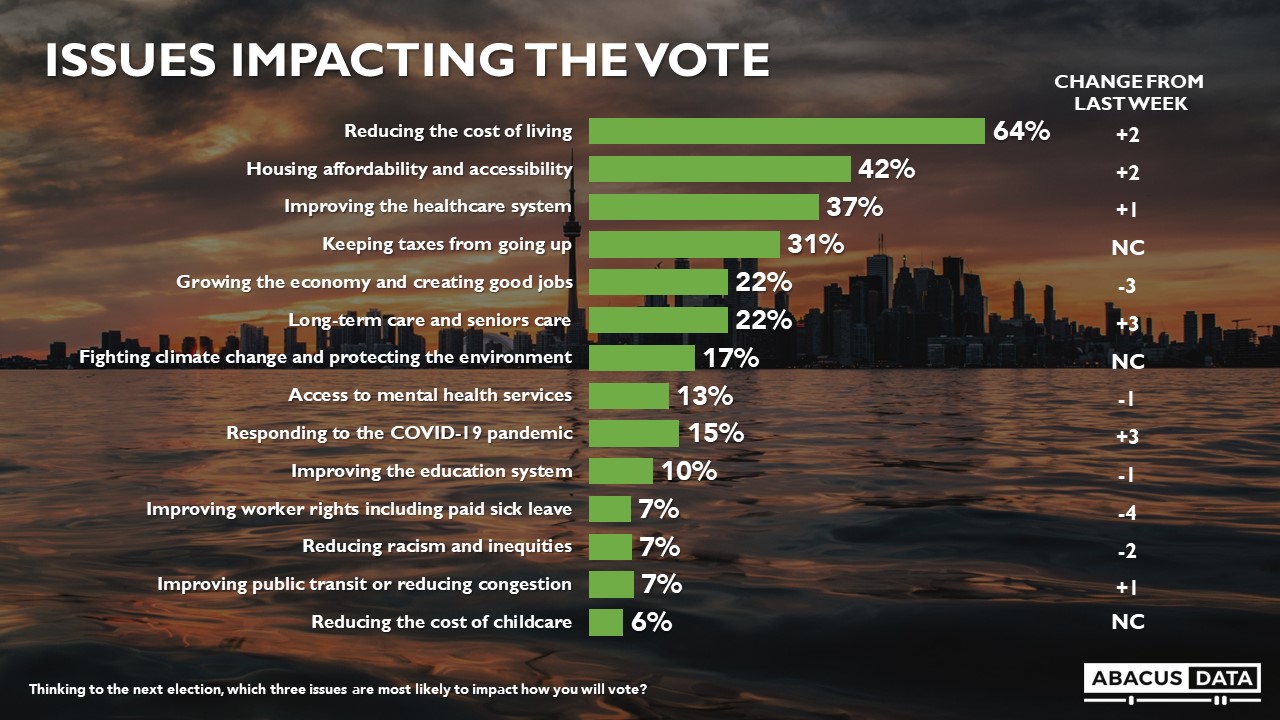
When those who ranked an issue in their top 3 were asked which party was best able to deal with it, the PCs lead in reducing the cost of living, keeping taxes from going up, and growing the economy. There are slightly behind the NDP on housing affordability and in a three-way tie with the OLP and NDP on improving the healthcare system.
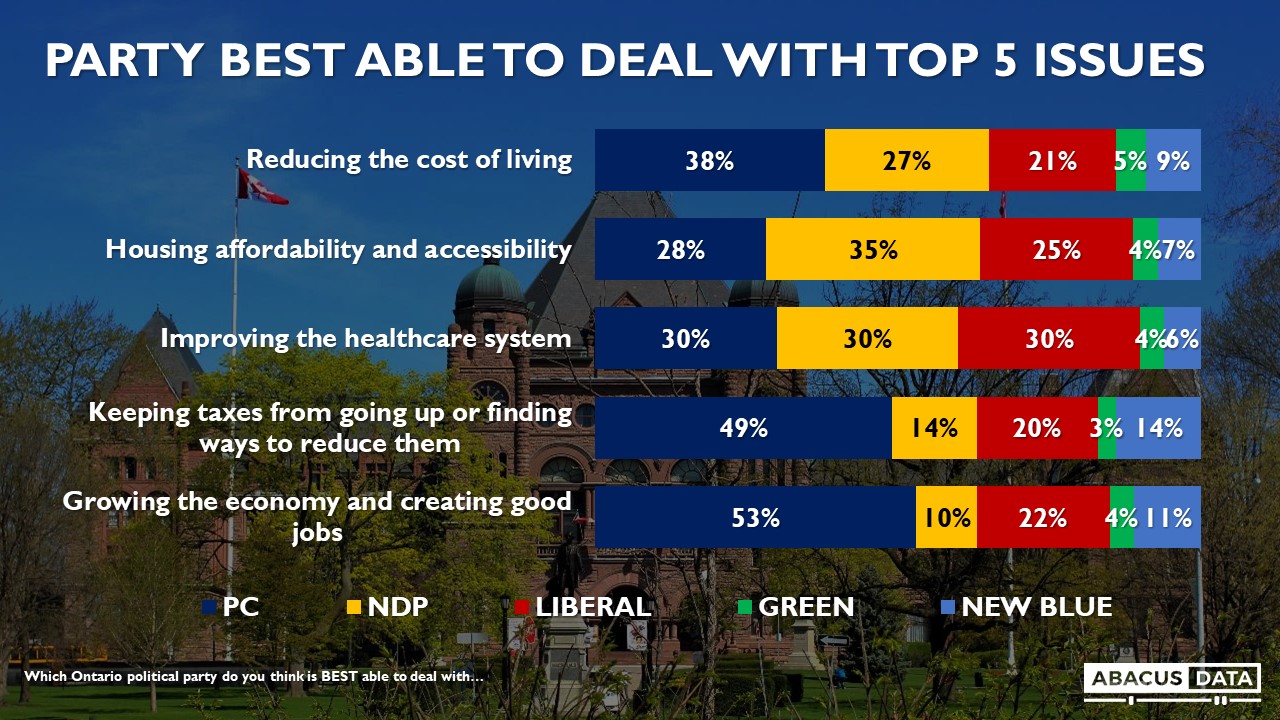
A FEW OTHER INTERESTING RESULTS:
#1 – PROBLEM DEFINITION: More think the cost of housing, health professional shortages, wait times for surgeries, and poverty are big problems in the province. Far fewer think traffic congestion, cancel culture, or class sizes are big problems.

#2 – PROBLEM DEFINITION & THE VOTE: The PCs lead among those who think the cost of housing is a big problem, as well as those who say health professional shortages, wait times, and those unable to find a family doctor are big problems in the province.
Among those who say climate change is a big problem, the NDP is ahead by 7 over the OLP with the PCs in third. Among those who say the cost of university and college tuition is a big problem, the NDP, OLP, and PCs are basically tied.
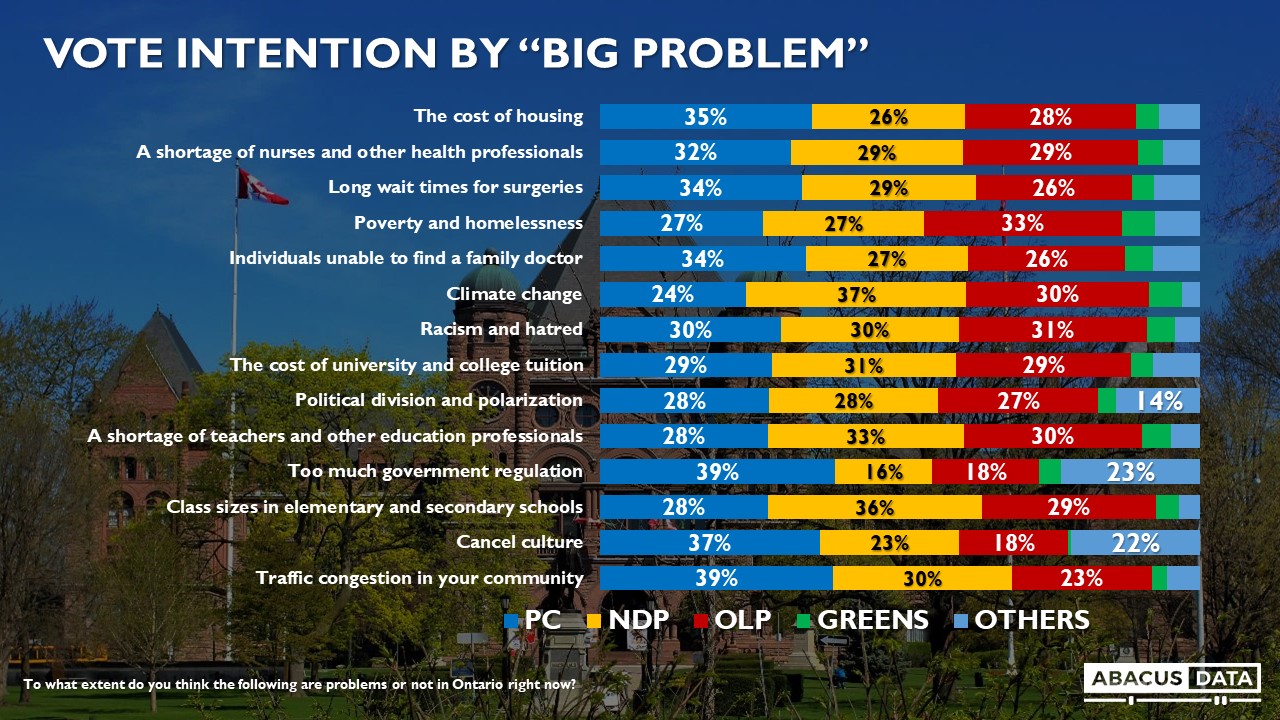
The New Blue Party and other parties do best among those who say “too much government regulation”, “political division and polarization”, and “cancel culture” are big problems in the province.
#3 – HIGHWAY 413: 47% of Ontarians either support or can accept building Highway 413 while 30% are opposed.
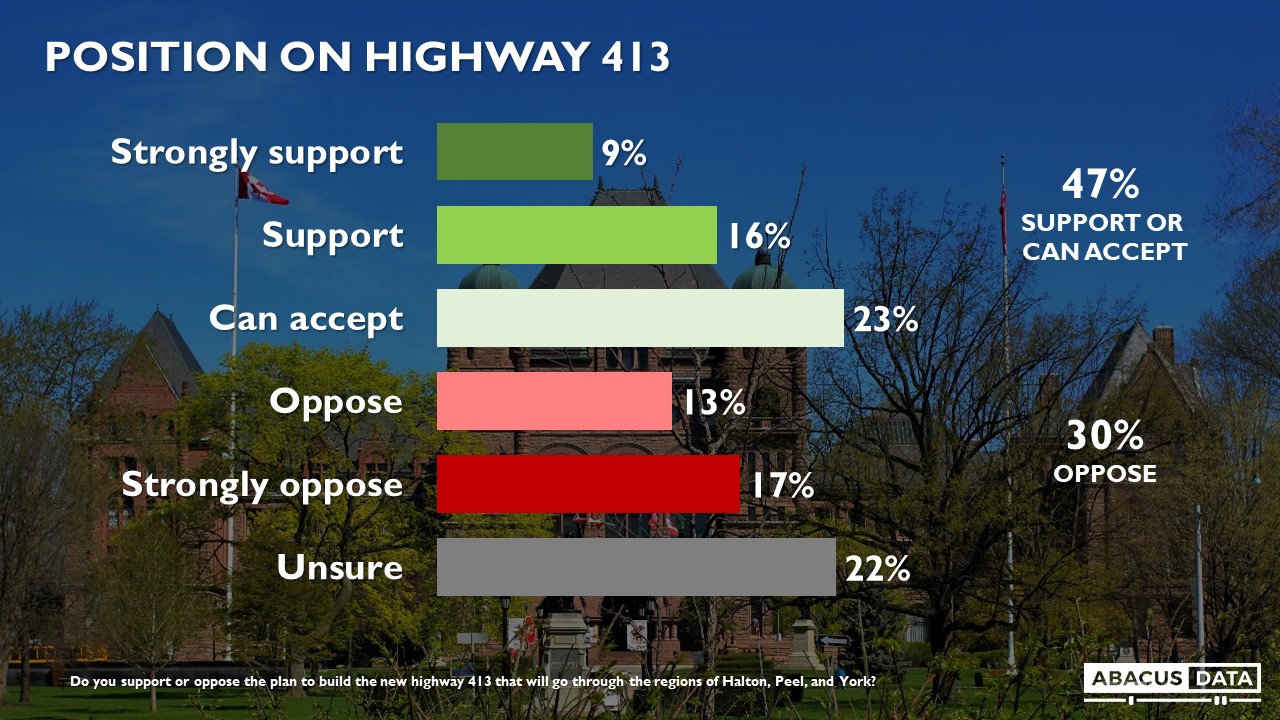
Support or acceptance of the highway is fairly consistent across the province with 51% supporting/accepting in the rest of the GTHA.

The PCs have an almost 30-point lead among those who support building Highway 413, and a 21-point lead among those who can accept it while the NDP and Liberals are almost evenly split and tied among those who oppose it.

#4 – BILL 124 AND PUBLIC SECTOR PAY FREEZES: Ontarians are almost evenly divided on whether it is a good idea or bad idea for the provincial government to freeze most public sector workers’ pay increases to 1% per year. 34% think it is a good idea while 38% think it is a bad idea. PC supporters are more likely to favour it while NDP supporters are more likely to oppose it. OLP and Green supporters are more split.
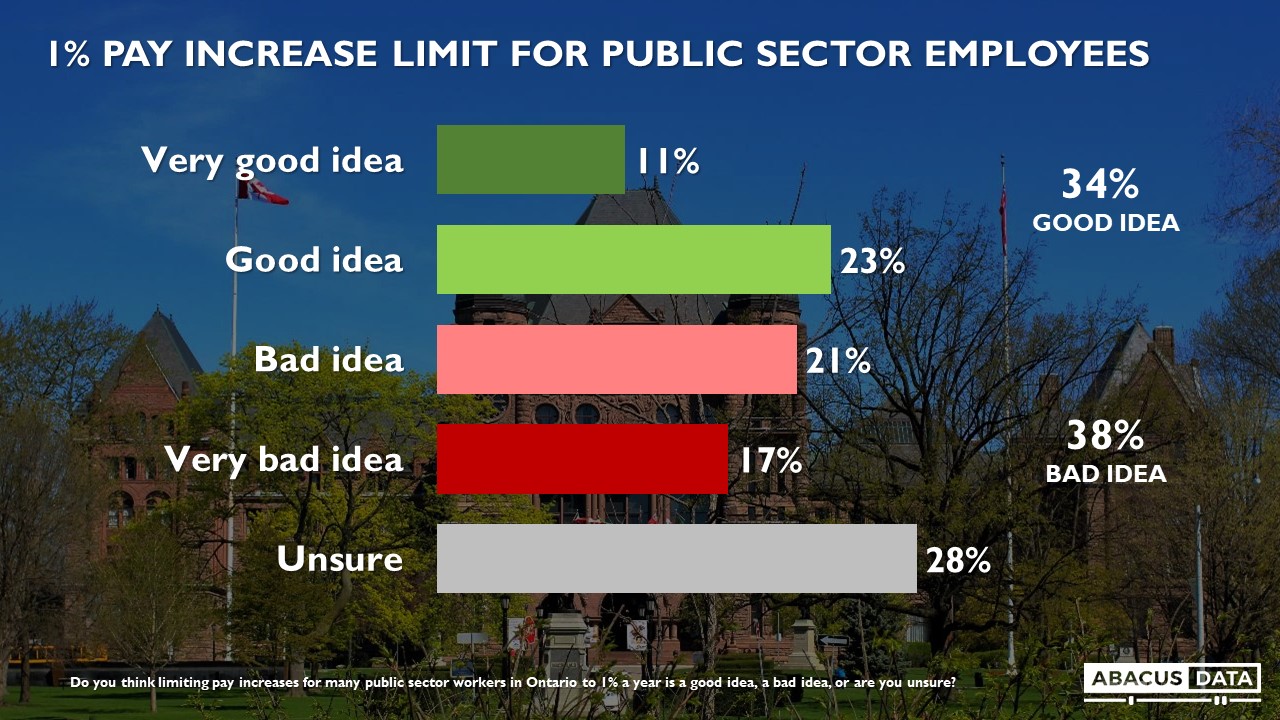
When asked to pick between two statements regarding Bill 124, framing the decision to freeze public sector wage increases at 1% as unfair and bad public policy gets far more traction than the fiscal constraint argument. Even 46% of PC supporters are inclined to think the wage freeze is bad public policy when it’s framed around recruitment and retention.


UPSHOT

According to David Coletto: “Very little has changed over the past week. The PCs continue to have a healthy lead overall, and an even larger lead among more motivated voters. The debates have done little to change people’s impressions – if anything, voters were generally impressed with all four leaders and therefore Doug Ford came out the real winner.
The desire for change is down, Ford’s personal image has improved, and the PCs still dominate three of the five top issues in the campaign, including the most important issue – the cost of living.
The NDP and Liberals continue to evenly split support among “change voters” and neither has any momentum at the moment. If this doesn’t change in the next week, Doug Ford should easily get re-elected as the Liberals and NDP fight it out for second place.”
METHODOLOGY
The survey was conducted with 1,500 eligible voters in Ontario from May 18 to 21, 2022. A random sample of panelists were invited to complete the survey from a set of partner panels based on the Lucid exchange platform. These partners are typically double opt-in survey panels, blended to manage out potential skews in the data from a single source.
The margin of error for a comparable probability-based random sample of the same size is +/- 2.6% 19 times out of 20.
The data were weighted according to census data to ensure that the sample matched Canada’s population according to age, gender, educational attainment, and region. Totals may not add up to 100 due to rounding.
This survey was paid for by Abacus Data Inc.
Abacus Data follows the CRIC Public Opinion Research Standards and Disclosure Requirements that can be found here: https://canadianresearchinsightscouncil.ca/standards/
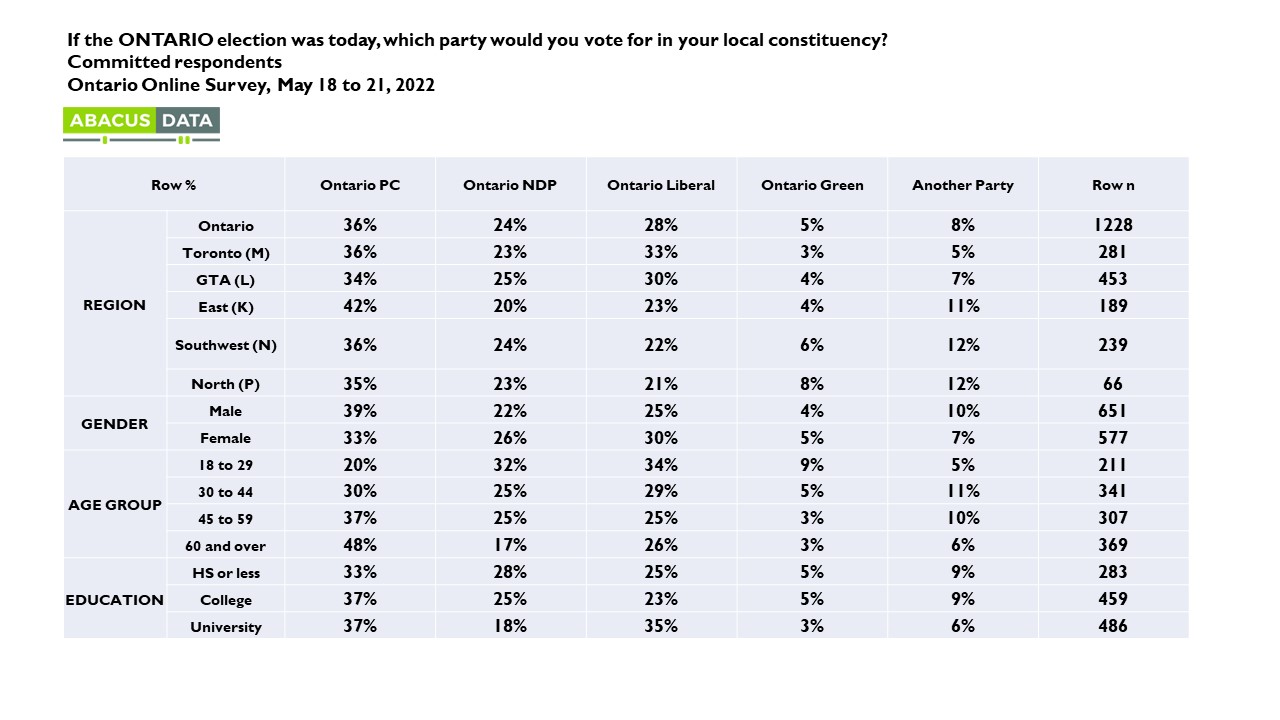
ABOUT ABACUS DATA
We are the only research and strategy firm that helps organizations respond to the disruptive risks and opportunities in a world where demographics and technology are changing more quickly than ever.
We are an innovative, fast-growing public opinion and marketing research consultancy. We use the latest technology, sound science, and deep experience to generate top-flight research-based advice to our clients. We offer global research capacity with a strong focus on customer service, attention to detail, and exceptional value.
We were one of the most accurate pollsters conducting research during the 2021 Canadian election following up on our outstanding record in 2019.
Contact us with any questions.
Find out more about how we can help your organization by downloading our corporate profile and service offering.



